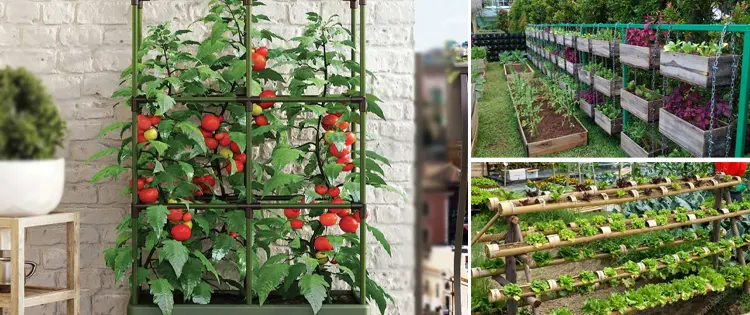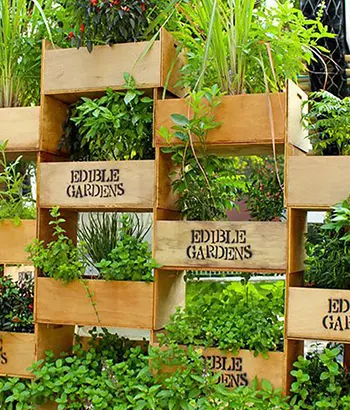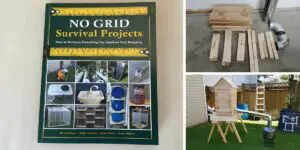Vertical gardens are an incredible way to save space (or condense gardens for smaller areas) and they help save time watering. After all, if all of your plants are in one spot, it’s a quick and easy watering time. Right?
The biggest question I’ve always been asked is if it’s viable to build your own vertical garden or if you should just go ahead and purchase one of those little stands and work with it. The question I answer back with is: how handy are you? Personally, I’m a disaster when it comes to building things. I buy pre-made vertical gardens because if I built my own, they’d probably fall apart before a single season was over.
There are thousands of different designs online for vertical gardens, but if you feel like you want to try your hand at putting together a vertical garden, go for it! But there’s nothing wrong with buying one at your local garden center, either. Do what suits you best.
Overfilling and Other Problems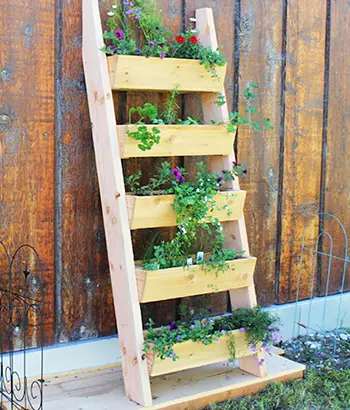
Though I love vertical gardens, some of the biggest problems come from overwatering, over-fertilizing, and overfilling. You’ll notice that the top layer of your vertical garden is often dry long before the rest of your tower is; that’s a common issue. Since these towers tend to use a trickle-down method to water, feed and provide nutrients for your plants, you may have some serious problems keeping everything just the way it should be.
Tread carefully. Vertical gardens really aren’t for beginners and take some serious planning. Let’s look at what you can plant and where.
Fruits and Vegetables
Strawberries are the pinnacle for any small planting area, especially those that may include pockets. These shallow-rooted, easy-to-grow plants love to tuck into a nook and produce like crazy. Bush beans are another wonderful choice that is very tolerant of all potential issues with vertical gardens. We also suggest plants such as miniature eggplants (possibly full-sized if you have a very large vertical garden), small varieties of peppers; typically the spiciest around, garlic, and both spring and typical onions.
However, perhaps the most common vegetables to grow in a vertical garden are greens. Mustard, turnip, lettuce, kale; any green loves to settle into a pocket or a fold or any small planter and will continue to produce throughout the season for you as you trim. Even better, you can easily move most small to medium vertical gardens out of the sun if your greens are getting a little too much heat as the season progresses.
Herbs
My favorite plant to put in a vertical garden is mint. Not only is a mint variety vertical garden gorgeous, but you can get as much tea as you can dry and carry out of it all season long; and sometimes even into the winter depending on your grow zone. Mints love coming indoors when it’s too chilly outside and a small vertical garden is perfect for just such an experiment.
Rosemary is another wonderful addition to your vertical garden, as is thyme. In all honesty, any herb is a great one to choose for your vertical garden so long as it is relatively compact. I wouldn’t suggest white sage since it grows to enormous heights and, as of this writing, is somewhat endangered in its native growing area, but cooking sage will work well, too.
Other fun herbs to grow in a vertical garden include basil (and let’s be honest, we can never get enough basil, right?), marjoram, aloe vera (though large aloes will need to be transplanted in the future, so make sure you plan for that, and oregano. Do be careful planting oregano near-certain varieties of rosemary since the two may not play very nicely if their oils are constantly all over one another.
Flowers and Other Pollinators
We’re adding a few herbs in here, so bear with us. Nasturtium makes an even prettier vertical garden than mint does, and so much of the plant is readily edible. If planting a vegetable garden in a verticle planter, we strongly recommend adding a few nasturtium seeds to another vertical garden nearby.
You can also use flowers such as miniature zinnias to draw in bees, butterflies, and typical pollinators. If you’re a big fan of roses, some very tiny miniature varieties can be grown in vertical gardens though, as, with aloe above, you may need to go ahead and transplant these in the future. Miniature daisies and Black-Eyed Susans can be grown right alongside these flowers to attract more beneficial insects.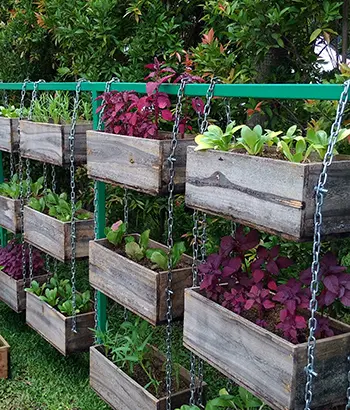
Lavender, echinacea, chamomile, and dozens of other flowering herbs can be used as pollinator attractors, too, in vertical gardens. And don’t be shy about intermingling these plants in large vertical gardens. A layer of flowers, a layer of vegetables, and keeping your herbs on top is totally within the norm for a vertical garden. Let your imagination run wild!
What Plants to Avoid
I realize a great many people keep succulents in vertical gardens. In recent years, as the popularity of succulents has exploded, there are so many gorgeous walls full of vertical gardens and succulent plantings. I think they’re gorgeous, but they seem to do best in their native, arid areas and not so well in areas where they’ll see too much humidity or sun while outside.
That said, if you’re going to try to put succulents in your vertical gardens, keep them in the top-most tier unless their exact care guide says to work differently with them.
Additionally, you’ll want to avoid any plants that grow very tall, are very heavy, or require staking. Tomatoes, squashes, melons, even kiwi vines; they’re all off the table for vertical growing. While you can force a runner bean to twist and turn all-around a miniature corn in a vertical garden, you’d do better to go on ahead and make a lasagna garden for them, a raised bed, or work in a different method.
Final Thought
In the end, vertical gardens are a little bit gimmicky but worth giving a shot. They’re a very good idea if you move frequently and want to be able to tip your garden out and start new elsewhere, or if you simply aren’t sure about this whole gardening thing yet but you have some experience in the past. I generally don’t recommend them for very raw beginners simply because once something starts to go wrong, it can take out your entire garden very quickly. And oftentimes, catching a problem early simply isn’t yet built into a beginner’s wheelhouse of gardening understanding quite yet. Give it your best shot no matter where you are on the gardening grid and happy planting!
You may also like:
The Herbs You Need to Keep Close During Dark Times (Video)
7 Common Raised Bed Mistakes Every Person Should Avoid
How To Organize Your Garden For Maximum Harvest
Ingenious Ways To Use Toilet Paper Rolls That You Never Thought Of

